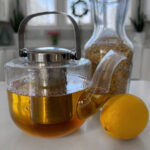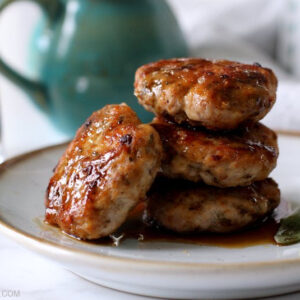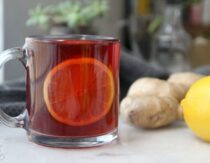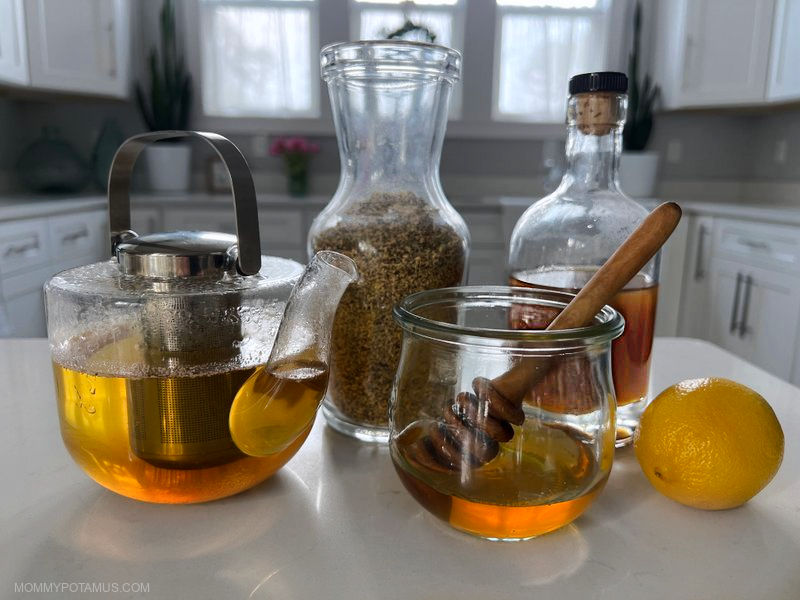
Elderberry syrup is pretty much a staple in most natural remedy toolkits, and for good reason. Rich in compounds that support immune function, aid vitamin C absorption and more, it has a long history of use as a traditional herbal remedy.
If you visit just about any European pharmacy in the winter, though, you’ll find that it’s not just the berries of the elder plant that are prized for their therapeutic properties. The lacy flowers of the black elder tree are among Europe’s most esteemed natural remedies, which is why you’ll find a variety of both berry and flower-based products stocked throughout Europe. 1
They’re easily found in the United States, too, but the benefits are less well-known. Traditionally, elderflowers have a long history of therapeutic use for cold and flu support, seasonal allergy relief, skincare, stress relief and more. They’re also delicious, which is why they’re used to make jam, infused honey, cordial and wine.
Renowned herbalist Rosemary Gladstar even makes them into fritters by frying them in a golden batter, which is then served with elderberry jam as a dipping sauce. 1
In this article we’ll dive into elderflower’s benefits and safety, plus how to use it to make teas, tinctures, elixirs, syrups and more.
Before we dive in, though, I want to remind you that that none of these statements have been evaluated by the FDA, this article is not medical advice, and it’s not meant to diagnose or treat any condition. If you have a question about whether any herb or dietary supplement is right for you, please talk with a qualified healthcare professional. Now that we’ve got that out of the way, you might be wondering . . .
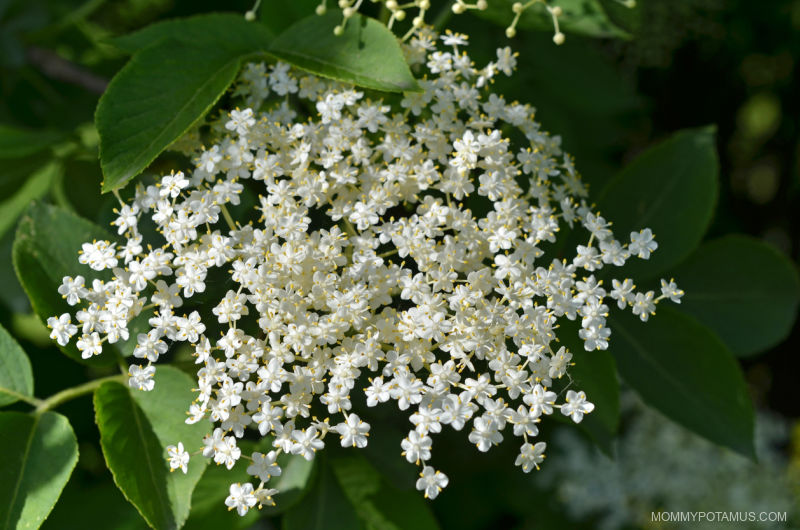
What is elderflower?
As its name implies, elderflower is the flower of the black elder tree (Sambucus nigra), which is native to North America, Europe, western Asia, northern Africa, New Zealand, Australia, and many Pacific islands. 2
It blooms from late spring to early summer, and the flowers have been used for centuries to promote healthy respiratory function, support the immune system, and soothe inflammation.
Research has identified several compounds that are thought to contribute to its therapeutic properties: flavonoids/flavones (quercetin, rutin, and kaempferol), triterpenes (ursolic acid, oleanolic acid, a- and b-amryin), sterols, fixed oils (mainly linoleic, linolenic, and palmitic acids) and phenolic acids. 3 4 5 6
Here’s an overview of its traditional uses, plus the modern research that supports them.
#1 – Cold, Flu & Respiratory Support
Elderflower is approved by German commission E for cold support, and as I mentioned earlier it’s traditionally been used for flu support as well. 7 Here’s a quick overview of it’s main therapeutic benefits:
- Research suggests that it helps balance our immune system’s defense mechanisms.8
- It’s also classified as a diaphoretic, which is an herb that supports the body’s natural fever process by encouraging sweating to help the body cool naturally. 1 9 Traditionally, it’s taken as a hot tea to promote sweating, sometimes with other herbs including yarrow.
- Cooled elderflower tea infusions can also be gargled to soothe a sore throat or used as a mouthwash to soothe gum inflammation.
- According to JJ Pursell, author of The Herbal Apothecary, it also supports the body’s natural clearance of mucus and “promotes the draining of it through the bladder.”
Elderflower is often combined with yarrow, peppermint, horehound and/or chamomile for cold and flu symptom support. 9 It’s also sometimes used with hyssop to soothe discomfort from coughing.
#2 – Counteracts Oxidative Stress
Our bodies produce inflammatory free radicals when we break down toxins, so we need a rich supply of antioxidants to mop them up. Otherwise, excessive buildup of free radicals can damage tissues, accelerate aging, and cause other issues.
Elderflowers are rich in antioxidant flavones that help neutralize free radicals. In fact, the flowers contain up to 10 times more flavones than the berries, resulting in “a much stronger neutralizing activity of free radicals compared to elderberry fruit.” 8 3
#3 – Seasonal Allergy Support
Elderflower tea, taken consistently in the weeks leading up to (and during) allergy season, has been traditionally used to ease symptoms like runny nose and watery eyes.
Modern research has found that elderflower extracts have a modulating (balancing) effect on inflammation, and herbalists believe it’s this therapeutic aspect of elderflower that supports clear sinuses while calming irritation. 4
It’s often combined with nettle for seasonal allergy support.
#4 – Skin Health
Elderflower is rich in antioxidants that can counteract free radicals (inflammatory molecules that contribute to premature aging if present in excessive amounts). It’s inflammation balancing properties have also made it a favorite for supporting skin clarity and/or soothing a sunburn.
Cooled elderflower tea can be used as a skin wash or compress, or the flowers can be used to make a skin salve using the same method (and measurements) I use with calendula flowers. 10 9
#5 – Relaxation & Stress Support
According to Katja Swift and Ryn Midura, authors of Herbal Medicine for Beginners, elderflower “can also work emotionally, helping release intense emotions or worry and allowing the mind to relax.”
Katja particularly loves a blend of elderflower, chamomile and linden to help relax her “Type A” personality at the end of the day. This can be made into a tasty tea with equal parts of each herb. Served with a spoonful of honey, it is great way to transition from work to home.” 11
She adds that it can be taken freely as a hot tea for “stress management or as a tincture or elixir for releasing feelings of stress.” 11 You’ll find a simple recipe that incorporates elderflower, chamomile and linden below.
# 6- May Support Balanced Blood Sugar
Research suggests that elderflower extract optimizes our muscles capacity for glucose uptake. Our muscles absorb and metabolize about 80% of the glucose that is released into our bloodstream after eating, making them an important regulator of glucose homeostasis. 12 13
In other words, our muscles help us maintain balanced blood sugar levels, and elderflower extract seems to help optimize their function.
Does elderflower have any side effects?
The Botanical Safety Handbook, 2nd edition, classifies it as a Safety Class 1A herb – the safest rating possible. It is described as:
- Herbs that can be safely consumed when used appropriately.
- History of safe traditional use
- No case reports of significant adverse events with high probability of causality
- No significant adverse events in clinical trials
- No identified concerns for use during pregnancy or lactation
- No innately toxic constituents
- Toxicity associated with excessive use is not a basis for exclusion from this class
- Minor or self-limiting side effects are not bases for exclusion from this class
Additional safety considerations:
- According to Katja Swift and Ryn Midura, authors of Herbal Medicine for Beginners, “Unlike some immune-stimulating herbs, elder is typically well tolerated in individuals with autoimmune conditions.”
- All fresh parts of the plant can “cause nausea and diarrhea. Even dried, the stems, bark and roots contain enough residual compounds to induce nausea. The flowers should be dried before using.” 9
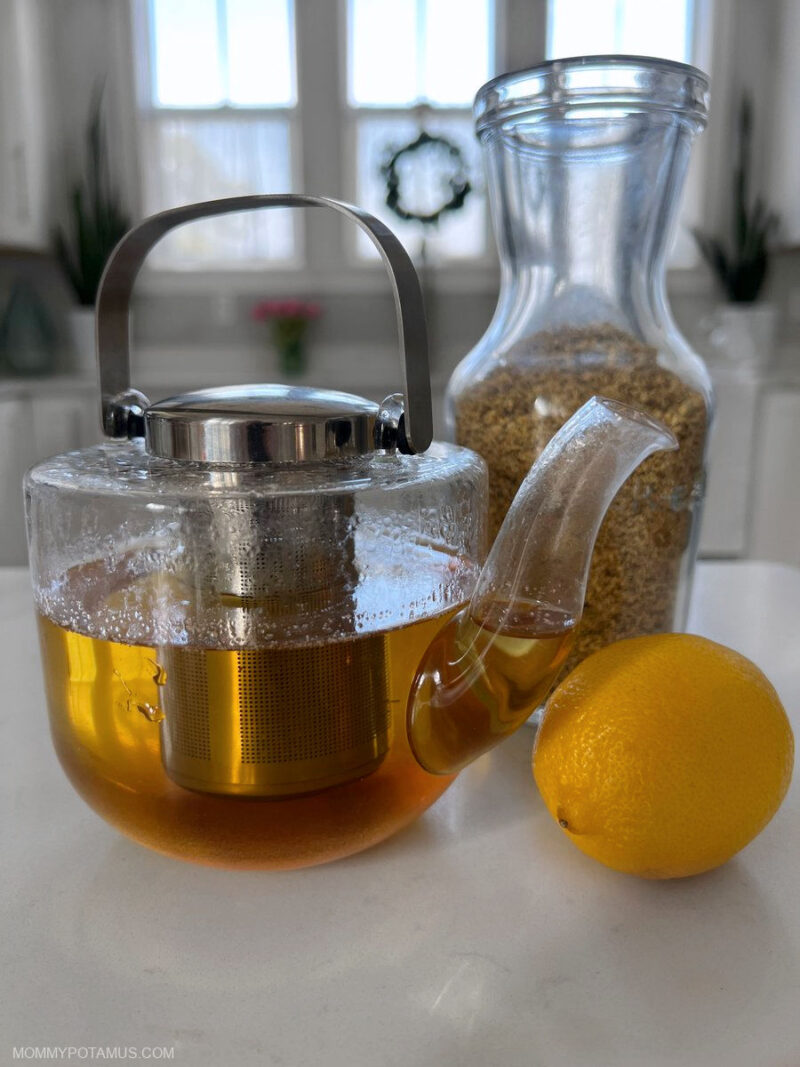
7 Elderflower Recipes To Try
As I cover in this article, there are many different ways to extract beneficial compounds from plants. Some work better than others depending on the composition of the herb you’re working with – here are some of the best options for elderflower:
Basic Elderflower Tea Recipe
This simple herbal tea has a nectar-like floral flavor that makes it enjoyable as well as therapeutic.
Ingredients
- 2 teaspoons dried elderflowers
- 1 cup boiling water
- honey or other sweetener (optional)
To Make
Pour 1 cup of boiling water over the elderflowers. Cover and infuse for 10 minutes. Strain out the flowers and sweeten to taste if desired.
To Use
Medical Herbalism suggests drinking it hot three times a day.
Feel Better Soon Tea
- 1 part elderflowers
- 1 part yarrow
- 1 part peppermint
To Make
Create your blend by mixing equal parts of each herb together. You can use 1 tablespoon, 1/4 cup or any amount you want as long as you use the same amount of each herb.
Place 2 teaspoons of the tea blend in your infuser and pour 1 cup of boiling water over the herbs. Cover and infuse for 10 minutes. Strain out the herbs and sweeten to taste if desired.
Stress Release Tea Blend
As I mentioned above, Herbal Medicine for Beginners co-author Katja Swift uses a blend of elderflower, chamomile and linden to help relax her “Type A” personality in the evening. For those of you that like very specific instructions in terms of amounts and steeping time, here’s what I use:
- 1 part elderflowers
- 1 part chamomile
- 1 part linden
To Make
Create your blend by mixing equal parts of each herb together. You can use 1 tablespoon, 1/4 cup or any amount you want as long as you use the same amount of each herb.
Place 2 teaspoons of the tea blend in your infuser and pour 1 cup of boiling water over the herbs. Cover and infuse for 10 minutes. Strain out the herbs and sweeten to taste if desired.
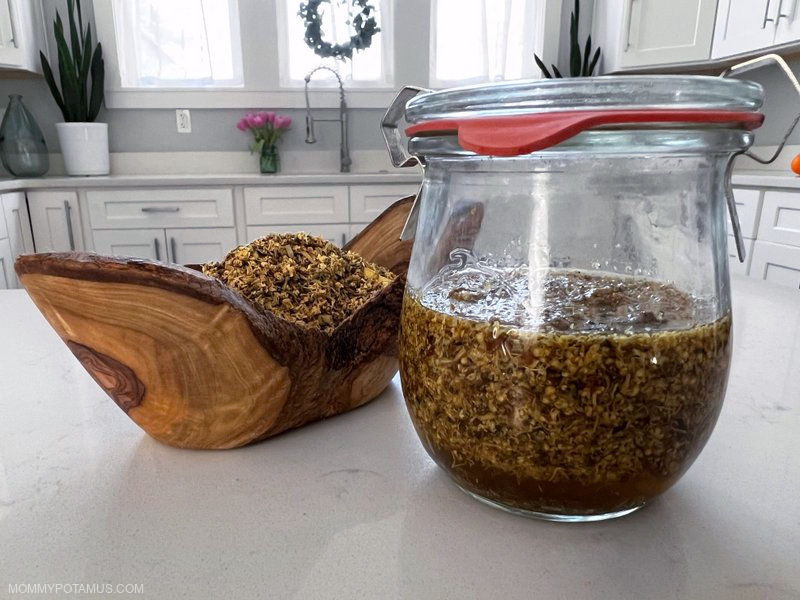
Elderflower Tincture Recipe
The tincture formula generally recommended for elderflower is a 1:5 ratio (1 ounce herb by weight, 5 ounces alcohol by volume) in 60% alcohol. However, because elderflower absorbs liquid easily, I have found that I need to add a little extra alcohol to make sure it is fully submerged.
Here’s how to make it:
Ingredients
- 1 ounce dried dried elderflowers (by weight)
- 5 ounces 120 proof alcohol, or more if needed (60% alcohol by volume)
To Make
Pour the alcohol over the elderflowers, then cover the jar with a lid and shake it well. If desired, write the start date on the jar using a sticky note, label, or piece of tape – it makes keeping track of how long it’s been steeping easier.
Place the jar in a dark, room temperature area. I keep mine in a kitchen cabinet. Let the mixture steep for 3-4 weeks. Shake occasionally.
When the tincture is ready, use a mesh colander or cheesecloth to filter out the herbs. Pour the tincture in a clean jar or dropper bottle and store it in a cool, dark area.
To Use
The Modern Herbal Dispensatory suggests 1-3 ml (0.2 – 0.6 tsp) two to four times daily.
How To Make Elderflower Syrup
Also known as elderflower cordial, this simple syrup is perfect for making soda, mocktails, herbal popsicles, lemonade, cocktails and more. Click here for the recipe + delicious ways to use it.
Elderflower Elixir Recipe
An elixir, which I hope you agree is a magical sounding word, is basically a sweetened tincture. To make it, use a 50/50 mixture of elderflower tincture (recipe above) and honey.
Elderflower Infused Honey Recipe
- ¼ cup dried elderflowers
- 1 cup light colored raw honey
Instructions:
- Pour the honey over the blossoms and then stir to make sure the honey and blossoms are well-combined.
- Place the jar in a warm spot away from direct sunlight. The top of the fridge is a good, warm spot.
- Allow the honey to infuse for 1-4 weeks, turning the jar over every day to redistribute the blossoms.
- When the honey has reached the flavor intensity that suits you, place a mesh strainer over a medium bowl and pour the honey mixture into the strainer. Because honey is so thick it will take a long time to strain, so wait a few hours before checking on it.
- Once you’ve finished straining out the elderflower blossoms, don’t toss them! Store them in the fridge and stir them into tea for an extra flavor boost.
Elderflower Tea Recipe
Ingredients
- 2 tsp dried elderflowers
- 1 cup boiling water
- honey or other sweetener (optional)
Instructions
- Pour 1 cup of boiling water over the elderflowers.
- Cover and infuse for 10 minutes.
- Strain out the flowers and sweeten to taste if desired.
Have a question about elderflower? Let me know in the comments below!
Want more research-backed natural remedies?
No problem, I’ve created a free ebook for you – Kitchen Apothecary: 25+ Natural Remedies Using Ingredients From Your Pantry – as a gift for signing up for my newsletter. You’ll also get updates when I post about safe essential oils for pregnant/breastfeeding mamas, exclusive gifts and coupons (I was able to give away a jar of free coconut oil to anyone who wanted it recently!), plus other goodies.
Sign up using the form below.
Sources
- Rosemary Gladstar (2012) Rosemary Gladstar’s Medicinal Herbs: 33 Healing Herbs to Know, Grow and Use
- Stephen Buhner (2021) Herbal Antivirals, 2nd Edition: Natural Remedies for Emerging & Resistant Viral Infections
- Georgiana Smaranda Marțiș (Petruț) et. al. (2021) The Physicochemical and Antioxidant Properties of Sambucus nigra L. and Sambucus nigra Haschberg during Growth Phases: From Buds to Ripening
- Giang Thanh Thi Ho et. al. (2017) Elderberry and Elderflower Extracts, Phenolic Compounds, and Metabolites and Their Effect on Complement, RAW 264.7 Macrophages and Dendritic Cells
- Donald Yance (2013) Adaptogens In Medical Herbalism
- David Hoffman (2003) Medical Herbalism: The Science Principles and Practices Of Herbal Medicine
- Mohaddese Mahboubi (2021) Sambucus nigra (black elder) as alternative treatment for cold and flu
- Andrzej Sidor and Anna Gramza-Michałowska (2015) Advanced research on the antioxidant and health benefit of elderberry (Sambucus nigra) in food – a review
- Thomas Easley and Steven Horne (2016) The Modern Herbal Dispensatory
- Richo Cech (2016) Making Plant Medicine
- Katja Swift and Ryn Midura (2018) Herbal Medicine for Beginners: Your Guide to Healing Common Ailments with 35 Medicinal Herbs
- Karla E. Merz and Debbie C. Thurmond (2020) Role of Skeletal Muscle in Insulin Resistance and Glucose Uptake
- California State University, Dominguez Hills. Glucose Homeostasis and Starvation

